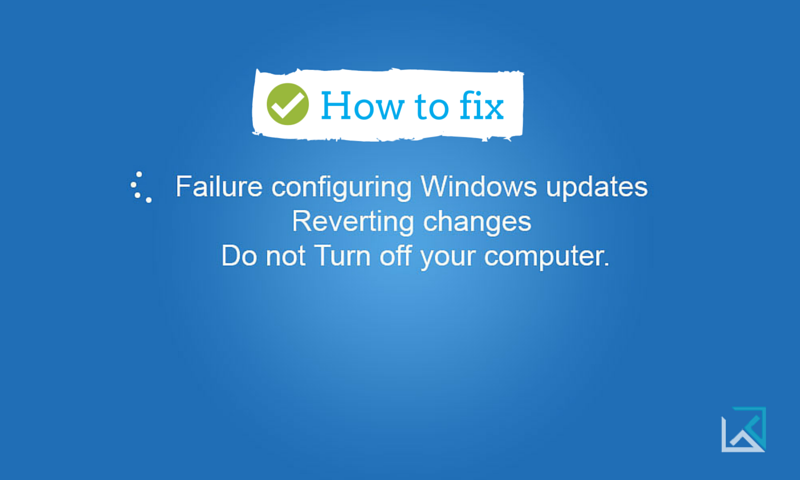
As you go about your day with a Windows PC, you may at some point be required to install certain updates. Whether you want to or not, some updates are necessary to maintain the security and stability of your system in a world of bugs, crashes and hackers.
Don’t miss: How to transfer Files From PC to PC at 125MB/s
Sometimes, an update may be required because you have formatted your PC or done a factory reset of the operating system. A not too uncommon error that may have crossed your path while installing Windows updates for whatever reason may be this:
“Failure configuring Windows updates. Reverting changes. Do not turn off your computer.”
The following solution might work for Windows 7, Windows 8 and Windows 10.
Here are the possible fix:
- Solution 1: Waiting It Out Might Actually Work
- Solution 2: Restart Your Computer
- Solution 3: Try Doing It In Batches
- Solution 4: Turn Off Secure Boot In Your BIOS
- Solution 5: Disable Microsoft Services
- Solution 6: Deleting The Update Cache
Solution 1: Waiting It Out Might Actually Work
To a lot of people, attention spans and patience in the modern day aren’t going to come easily. Ten seconds staring at an error screen can feel like an eternity doing nothing. However, waiting out the error and letting the OS do its thing may actually work.
Some forum users have reported that leaving their PCs in the error loop overnight has led to the rollback being performed in time and the updates being made to be installed again.
The key is not to panic when you are faced with the error loop. Don’t go for the nuclear option of a complete reinstallation just because it has begun to be a little buggy. Waiting it out should be your first course of action. If this doesn’t work, there are other solutions that have been proven to work well in most situations.
Solution 2: Restart Your Computer
If the loop keeps going, force your computer to restart. You can do this by holding the power button for 5 to 8 seconds until the screen goes black, and then pressing the power button again. You can also navigate to it through the Start menu.
After the computer has restarted, go to Control Panel > Updates and try reinstalling the updates.
Solution 3: Try Doing It In Batches
Typically, the error is caused by one of the updates being faulty. You can fix this by installing each update one by one until you find the culprit. This is a time consuming process, but it will help you figure out which of the updates are acting up, and then find a solution for those individual ones.
Navigate to the Windows Update Manager in your Control Panel and manually select each update and click Install. Do this one by one until the error code pops up again. This way, you don’t have to go through the pain of waiting over two hours before no updates install at all.
Solution 4: Turn Off Secure Boot In Your BIOS
Most computers that come with Windows 8 out of the box are configured with an UEFI chip. This is an integrated chip that makes sure all of the startup services on your computer are certified properly and are safe for your system.
The problem is that this can fail on certain updates for certain computers, even if the update is completely legitimate. If the UEFI certification check fails for an update that is being installed at the same time as a batch of others, the updates all fail simultaneously.
To fix this, follow the following steps:
- Turn off your computer (shut it down or press the power button).
- Push the power button. When the computer is booting up, check the bottom of your screen for a key warning (such as “Press F11 to go to BIOS settings”). This message is different on different makes and models. Once you see that notification, press the relevant key quickly. If you don’t make it in time, try again and be quick about it. This will take you to the BIOS menu.
- Once here, scroll through using the arrow keys or WASD until you find the “Secure Boot” or “UEFI Boot” options in the menu. There is usually a tab on the BIOS menu titled Boot or Security. Look through the entire BIOS menu for these.
- Find it and disable it by highlighting the option and pressing the Enter key. Select “Disable” using the arrow key and save your changes.
- Restart your computer.
After doing this, try to reinstall the updates again. For easier processing, try to install the updates in batches or in single file.
Solution 5: Disable Microsoft Services
This is another solution that a lot of users have found to be quite effective. It isn’t as complicated as disabling your Secure Boot from the BIOS.
- Open up a Run command window by pressing the Windows key + R or by clicking Start and typing Run in the search box.
- Type in
exeand press Enter. A windows should start up. - Click on the Services in this window.
- Check Hide all Microsoft Services at the bottom of the list.
- Click on Disable All and go forward with this command.
- Restart your computer and try to reinstall the updates.
Solution 6: Deleting The Update Cache
This is another solution that may just work for you if the others haven’t at this point:
- Open a Run command window (Windows key + R).
- Type
mscand press Enter. - Scroll through the list of services and look for Windows Update.
- Double click the service, then click Stop > OK in the window that pops up.
- Look in the list for Background Intelligent Service and stop it in the same way.
- Go to C: > Windows > SoftwareDistribution > DataStore and to C: > Windows > Software Distribution > Downloads
- Delete everything in these folders. It may ask you for administrator permission. Give it.
- Go back to msc and restart the Windows Update and Background Intelligent Service, and reinstall your updates.
If none of the above methods work, it may be time to contact your laptop or PC manufacturer, or an authorized repair outlet to help you with the issue. Alternatively, you can do a full system restore or reinstall Windows using your DVD installation copy.




What to do if nothing works and reverts back to being stuck on “failure to configure update” screen?
Solution 6 instructions are incorrect. Don’t type msc, type services.msc. and it’s not the Downloads folder, but rather the Download folder.
My computer is stuck in this loop. It is running Windows 7. Do you have any suggestions for how to actually get the computer to break out of the loop? Many of the steps suggested are assuming that we can actually get Windows to load fully. It will not go past the “failure” screen.